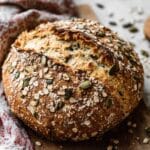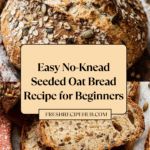No Knead Seeded Oat Bread Recipe
This No Knead Seeded Oat Bread is an easy-to-make, hearty artisan loaf packed with nutritious oats and a crunchy seed topping. With minimal effort and no kneading required, the bread develops a golden crust and a soft, airy crumb, enhanced by a gentle honey sweetness and a blend of pumpkin, sunflower, and flax seeds. Perfect for sandwiches or as a wholesome accompaniment to meals, this recipe uses simple pantry ingredients and relies on natural fermentation and a slow rise for deep flavor.
- Prep Time: 15 minutes
- Cook Time: 40 minutes
- Total Time: 3 hours 55 minutes to 3 days 55 minutes (including rising and optional refrigeration time)
- Yield: 1 loaf (about 12 slices) 1x
- Category: Bread
- Method: Baking
- Cuisine: American
- Diet: Vegetarian
Ingredients
Scale
Dry Ingredients
- 3 cups (390g) bread flour (spooned & leveled), plus more as needed for shaping and pan
- 2 teaspoons (about 6g) Platinum Yeast from Red Star instant yeast
- 1 cup (85g) old-fashioned whole rolled oats
- 1/4 cup (30g) unsalted pumpkin seeds (pepitas)
- 1/4 cup (30g) salted or unsalted sunflower seeds
- 2 Tablespoons (18g) flax seeds or sesame seeds
- 2 teaspoons coarse salt
Wet Ingredients
- 2 Tablespoons (43g) honey
- 1 and 1/2 cups (360ml) warm water (about 95°F / 35°C)
Topping
- 1 Tablespoon (5g) old-fashioned whole rolled oats
- 1 Tablespoon (8g) pumpkin seeds (pepitas)
- 1 Tablespoon (8g) sunflower seeds
- 1 teaspoon flax seeds or sesame seeds
- Optional: cornmeal for dusting pan
Instructions
- Watch the Reference Video: Begin by viewing the accompanying video to get a visual understanding of the process, which will guide you throughout the recipe.
- Mix Dry Ingredients: In a large ungreased mixing bowl, whisk together the bread flour and instant yeast. Add the oats, pumpkin seeds, sunflower seeds, flax seeds, and coarse salt, then whisk again to combine evenly.
- Add Wet Ingredients and Combine Dough: Mix the honey into the warm water until dissolved, then pour this mixture over the dry ingredients. Using a silicone spatula or wooden spoon, gently stir to moisten all flour. The dough will be very sticky and shaggy; you may need to use your hands to fully incorporate everything. Shape the dough into a rough ball within the bowl.
- First Rise – Room Temperature: Cover the bowl tightly with plastic wrap or aluminum foil and set it on the countertop at room temperature. Let the dough rise for about 3 hours until it nearly doubles in size and develops air bubbles.
- Optional Cold Fermentation: For enhanced flavor and texture, refrigerate the covered dough for at least 12 hours and up to 3 days. The dough will puff further and develop depth in taste. If using this step, proceed after refrigeration.
- Shape the Dough: Lightly dust a large nonstick baking sheet with flour or cornmeal. Using floured hands, gently shape the risen dough into a ball, taking care not to deflate it excessively. Transfer the shaped dough to the prepared baking sheet.
- Apply Seed Topping and Rest: Combine the topping oats and seeds in a small bowl. Sprinkle the mixture over the dough, gently pressing seeds into the surface to help them adhere. Loosely cover and let the dough rest for 45 minutes to rise slightly again.
- Preheat Oven: During the dough’s resting period, preheat your oven to 425°F (218°C).
- Score the Dough: Using a sharp knife or bread lame, score the top of the dough with a slash or X approximately 1/2 inch deep to allow for oven spring. If the dough has flattened, carefully reshape it.
- Prepare for Steaming (Optional): For a crispier crust, place a shallow metal or cast iron pan on the bottom oven rack. When ready to bake, pour 3 to 4 cups of boiling water into this pan and quickly close the oven door to trap steam.
- Bake the Bread: Position the baking sheet with the dough on the center oven rack. Bake for 40 minutes or until the crust is golden brown and the loaf sounds hollow when tapped. Alternatively, the internal temperature should reach 195°F (90°C).
- Cool the Bread: Remove the bread from the oven and allow it to cool on a wire rack for at least 10 to 20 minutes before slicing to ensure proper crumb setting.
- Storage: Store any leftovers loosely covered at room temperature for up to 3 days or refrigerate for up to 10 days.
Notes
- Dough is very sticky and too wet for kneading or mixer use; mixing by hand is recommended.
- Cold fermentation in the fridge is optional but improves flavor and crumb texture.
- Using cornmeal to dust the baking sheet helps prevent sticking and adds texture.
- Adding steam to the oven keeps the crust moist at the start of baking and helps it become crisper.
- Letting bread cool before slicing ensures it doesn’t become gummy inside.
- The loaf can be baked on a baking sheet, pizza stone, or in a Dutch oven for different crust results.
Keywords: no knead bread, seeded oat bread, artisan bread, no knead oat bread, easy bread recipe, homemade bread, bread with seeds, healthy bread
Find it online: https://freshrecipehub.com/no-knead-seeded-oat-bread-recipe/

